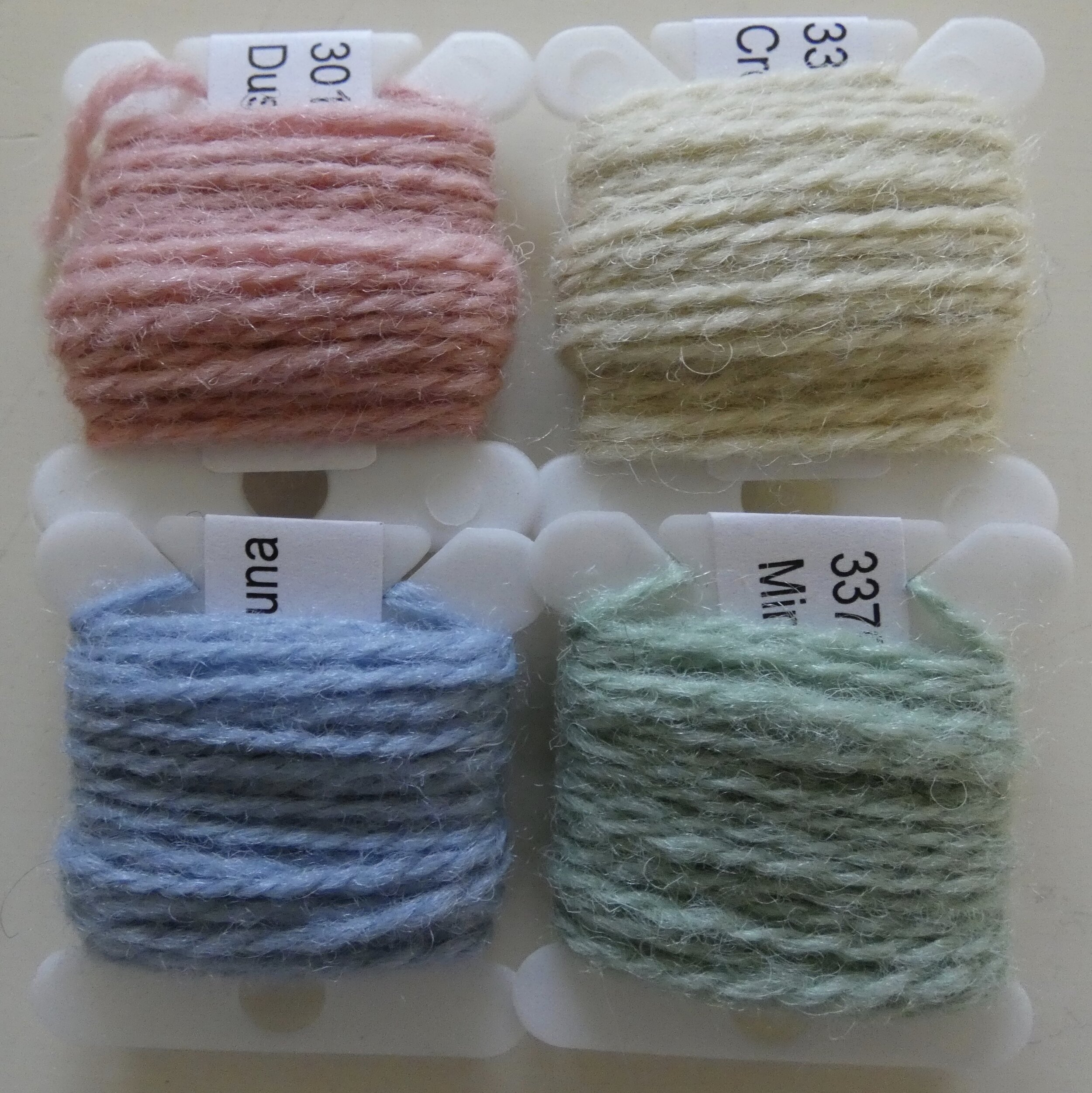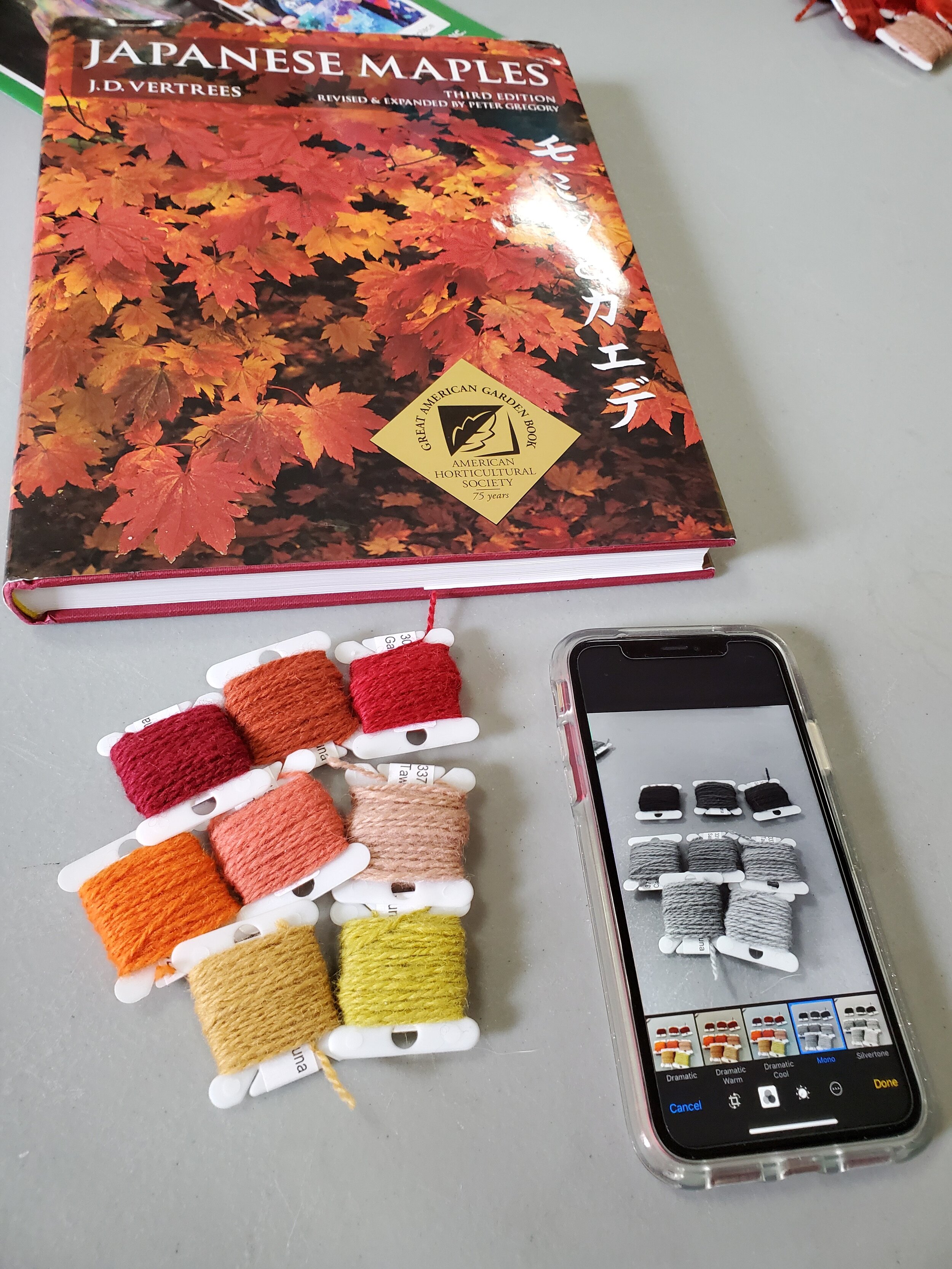How to Select Color Palettes for Knitting and Other Fiber Arts
At that place have been many articles written that highlight diverse perspectives and approaches to color selection. Understandably, there is always some overlap of content. Notwithstanding, no matter how many articles I read or videos I watch, I always seem to glean new pearls of wisdom, whether from a weaver, a spinner, a knitter, a dyer, or sometimes from a source non associated with the cobweb arts at all.
At last month'due south Guild coming together I presented a workshop on choosing colors and some of the resource that I take institute valuable. Information technology was well received so I thought I'd offer the information here.
ONLINE TOOLS
First, I'll talk near online tools. An internet search will uncover a gazillion wonderful color-related tools. The following are just a sampling that I find easiest to utilise and with the best application for my fiber arts purposes . . . and they're costless! I am not affliated with any of these sites, I just like and employ them.
I've created a PDF that includes this information with links in one swell handout. PDF Handout.
Color INSPIRATION
Design Seeds
https://www.design-seeds.com

This is i of my favorite color inspiration sites. The color palettes are inspired by cute photos, quite often from nature. At that place are a number of ways to use this site. Offset, there is a new color palette released daily. You tin too search by flavor (ex. fall), by color (ex. citrus), or by collection (ex. Sweet Tooth). It'due south truly eye candy and very addicting!

This tool generates a 5-colors palette. You can select the colors you want to keep and repeat the procedure until you accept the combination that matches what you want. You tin starting time with your own colors or a photo, only the beauty of this site is that it generates palettes without you even needing to have a colour in heed.

Here I've chosen to keep the terminal three colors, but generate a new combination by replacing just the start 2 colors.

Some other cool feature is that on each individual color you tin run into xx shades of that hue.


Adobe Color creates a colour palette by choosing a base colour and applying Color Rules (ex. monochromatic, analogous, etc.) or by extracting a colour palette from a photo similar I did higher up. Easy to utilise.

Here is an example of the tool applying the principle of complementary colors.

Another case, this time using shades and a monochromatic color scheme.

Adobe Color also has the option to change the Mood of the palette, here it'due south bright.



This site is not equally dynamic or easy to use, but it does have the feature 'Get Matches' that makes actual yarn recommendations to match your color selections.
SPECIAL COLOR TOOLS
Now that you've generated a spectacular palette, here are some tools to aid in the blueprint of a project that will complement your color choices.
Color Blend Tool Margaret Coe e-Weave Online
http://www.e-weaving.com/Gradations.html

This is a great tool if you lot want to practise a gradient projection. Pick 2 colors and and then the number of gradations yous desire (from i-10) and the tool blends those colors and gives you a gradient.
Random Stripe Generator Biscuits & Jam
http://www.biscuitsandjam.com/stripe_maker.php

This is a neat picayune tool that generates stripe patterns You enter your colors (choose from palette on site), desired stripe widths (choose as many as your want), and approximately how many rows. Voila a stripe pattern. If you lot don't similar that design, refresh the page and you'll become the same information you lot entered but in a different patten of striping. In add-on, you get a text version of your pattern.
Here are two boosted stripe patterns I generated all from the same choices of colour, stripe widths, and number of rows.



There are a number of tartan/plaid makers online, but I found this 1 to be the easiest to use. Yous tin use up to 3 colors and tin can vary the width of your bands.

I decided I wanted more aqua then I adjusted that band slightly up and decreased the bands of the other ii colors.


This is a fabulous color mixer to visualize warp & weft color choices in iv different weave structures: plain weave, 1/iii twill, 2/2 twill, and iii/ane twill. You can cull the color for the warp and weft either by picking the colour from a color grid/display or past uploading a photograph. There is too a feature to look at color blends ie., 75% warp/25% weft colour blend. And for the geeky (me!) information technology gives the colors in Hex code, RGB, and HSV.

You tin besides adjust the size of your blueprint to see how the colors interplay at dissimilar scales.
SELECTING YARN FROM A Color Bicycle

There are a plethora of articles, videos, and guides on how to select yarn using a color wheel. Quite oft this is done using the principles of color theory; analogous, complementary, monochromatic, etc. Simply I learned a valuable lesson from Emerge Melville, the well known knitting teacher, author, and pattern designer.
I'll share the essence of what I learned from her wisdom.
All colors in a color wheel get together. What doesn't become together is the different intensities of those colors. ——— Emerge Melville

Different intensities on the color wheel are shown in concentric circles, each of those are called tonal ranges.

The outside ring is where the colors are presented in their most bright system, the purest hues.

Side by side, if white is added they are called tints or pastels.

If we add together greyness, these are called tones or dusties.

And finally when black is added, these are shades or dark colors, frequently also called jewel tones.
Then if you stay within a tonal ring of the colour wheel, all the colors will go together.
PRACTICAL Case - Choosing Colors for Stranded Colorwork

And so we accept our inspiration photo and our color palette is generated, now what? Nosotros go to our yarn stash or a yarn shop and we're completely overwhelmed facing a wall of possibilities.
I found a wonderful video tutorial by Felicity (Felix) Ford. She has a organisation for choosing colors for stranded colorwork. Felix created a stranded color work blueprint with an adjustable motif (Skystone Armwarmers) which could exist knit in dissimilar colours to utilize a broad range of inspiration sources.
Here is a link to her blog post and a link to her YouTube video.
Using Felix'southward system, I had my fellow Society members pull together their yarn choices using a couple inspiration items I gave them. Their didactics was to select 5 pale shades for the pattern and 3 darker shades for the groundwork, aiming for a total of eight shades.
Here are the palettes they designed . . . . .



Reds, Oranges, Yellows
A final thought, y'all'll never apply all the colors you find in the inspiration source; it's a juggle of your budget, what'southward commercially available (or you can dye), and what's sensible to use in a project.
Thank you to Lisa Murray, Society fellow member, for taking the last 3 photos.
Addendum (3-21-20)
Run up Palettes
https://stitchpalettes.com

Stitch Palettes falls under the category of Color Inspiration, only with added bonuses. The palettes are isolated from photos and and then matched to DMC embroidery thread colors. There is a new color palette released daily. Like Design Seeds, y'all can search past color, by season (ex. Spring), past scheme (ex. pastel), or past theme (ex. floral). But lest you think this is only for embroidery, oh no!

Not just does Krisztina provide the DMC floss matches, but she also converts to DMC Tapestry Wool and Anchor Stranded Cotten.

She too provides the HEX, RGB, and CMYK color codes.

And just in case the palette is not exactly what you had in mind, there are suggestions for similar palettes that share the same colors.


freudenburgcomead98.blogspot.com
Source: https://florafiber.live/blog/choosing-colors-my-pearls
0 Response to "How to Select Color Palettes for Knitting and Other Fiber Arts"
Post a Comment